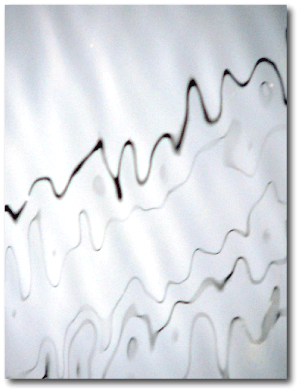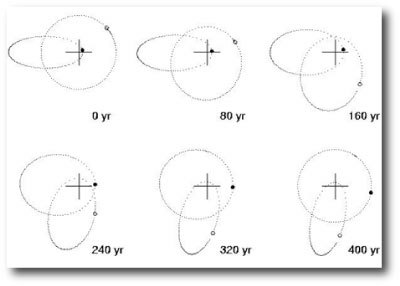I’ve got an upcoming event planned in New York City that should be pretty interesting. From the UCSC Newsletter:
UCSC astronomer joins composer Philip Glass to explore music of the universe
UC Santa Cruz Astronomer Gregory Laughlin joins acclaimed composer Philip Glass February 21 in a “Brainwave” discussion at the Rubin Art Museum in New York.
For its third year and in conjunction with the exhibition Visions of the Cosmos, Brainwave is a series of 20 sessions this winter and spring that bring together eminent thinkers from multiple disciplines with neuroscientists and astrophysicists to ponder big thoughts about “things that matter.”
Laughlin and Glass appear in the third Brainwave event titled “How Do We Listen to the Music of the Spheres?”
Laughlin is a professor of astronomy and astrophysics whose research delves into orbital dynamics and the evolution of planetary systems. Glass is one of the most influential composers of the past half-century. Though sometimes called a “minimalist,” Glass describes his compositions as “music with repetitive structures.”
Laughlin said he and Glass will explore commonalities between music and orbital dynamics. The museum’s initiative to pair the two was sparked in part by Laughlin’s articles on his blog oklo.org that delve into ways to “sonify” planetary movements.
He developed software to map planetary systems as audible waveforms. He said he became intrigued by the realization that planetary systems can be used as a type of nonlinear digital synthesizer and can provide an enormous palette of sound — sounds never before heard.
The Laughlin/Glass Brainwave session begins at 6 p.m. Sunday, February 21 at the Rubin Museum of Art at 150 West 17 St., New York City. Admission is $25.
Over the next week, as I’m preparing for the event, I’ll be working extensively with the sonification capability of the systemic console. Just below, is a reprinted post that touches on this very cool, and still relatively unexplored feature. If you’ve worked with the Console’s N-body sonification, and if you’ve found interesting results, feel free to send me .fit files — an extraordinarily effective form of compression(!) — and I may be able to use them in the discussion.
Potentially the most interesting feature on the downloadable systemic console is the “sonify button”, which integrates the model planetary system specified by the state of the console sliders and produces a .wav format CD-quality audio file of the resulting radial velocity waveform. Not interested in planets? The console is a stand-alone non-linear digital synthesizer. It’s capable of producing strange, remarkable, musically useful sounds. They merely need to be located within the uncountable infinity of solutions to the gravitational N-body problem.
First, use the console to build an interesting multi-planet system (for this purpose, there’s no need to try to fit whatever data is in the window.) Then click the sonify button. This brings up a dialogue window which enables the user to make several specifications for the sound file that is produced.
The most important user-specified parameter is the frequency onto which the orbital period of the shortest-period planet on the console is mapped. If, for example, the innermost planet has a period of 365.25 days, then a 440 Hz map will play 440 years worth of evolution in one second. (440 Hz corresponds to the A below middle C.) Mapping the radial velocity curve onto a high-frequency note extends the total number of orbits that go into the sample, and thus increases the integration time required to produce the sample. You can also specify the length of the sample, and you can exert simple control over the attack and decay rate of the envelope for the overall waveform.
Once you’ve produced the sound file, it appears in the “soundClips” subdirectory within the systemic parent directory. Both of these directories are automatically created when you download and expand the console — see the instruction set for the downloadable console for more details. With a Macintosh, you get the best results if you play the sample right from the folder. i-Tunes seems to want to convert the samples to .mp3 format in a manner that introduces audible noise, and we’re not yet sure how to resolve this issue.
To the extent that planets orbit independently of one another, the console behaves like a simple additive synthesizer, in which the individual Kepler waveforms add to form a composite sound. Much more interesting, is the situation when planets experience significant gravitational interaction, leading, for example, to resonance and to nonlinear instability (here are examples, 1, 2, from the resources page of both types of waveforms). Close encounters provide discontinuities between individual blocks of sound that resemble the results of granular synthesis.
The strongest 2-planet mean-motion resonances occur when the pair of planets share a common period and engage in a one-to-one resonant motion. There are a variety of different one-to-one resonances, including binary planet orbits (e.g. Earth and Moon), trojan configurations, and generalizations of retrograde satellite orbits. In this last category, one can have two planets with the same semi-major axis, but with different eccentricities. If one starts the planets in the following configuration, then the motion is dynamically stable, and evolves in a complicated way over time.
The motion leads to an interesting audio wave-form, in which you can hear the system cycling between configurations in which both planets are modestly eccentric and configurations in which one orbit is nearly circular while the other one is highly eccentric. As a specific example, set the console to the following configuration: P1=P2=10 days, M1=M2=0.3 Mjup, MA1=180., MA2=190., e1=0.9, e2=0.1, long1=0.0, long2=0.0. If you increase MA2 to about 225 degrees while keeping the other parameters fixed, you’ll hear the system go unstable.
Evolving, high-eccentricity orbits tend to have an insect-like quality, which brings to mind the 1986 album, The Insect Musicians, by Greame Revell (formerly of SPK). From the album jacket:
For the two years 1984-85, Graeme Revell traveled from Australia to Europe, to Africa, Indonesia and North America recording and negotiating copyrights of insect sound recordings. It took another full year sampling and metamorphosing some forty sounds thus gathered using the Fairlight Computer Musical Instrument, to produce this record. The only sounds used are those of insects, altered digitally and combined into a unique orchestra of instruments, an orchestra of strange and delicate timbres, music of natural rhythm and texture.




I am truly fascinated by this! What a fun and unique way to observe the universe! This would be wonderful for people who are blind and also as a tool for teaching young people about both astronomy and music. This would be a wonderful subject of exploration for gifted students as well. Amazing!